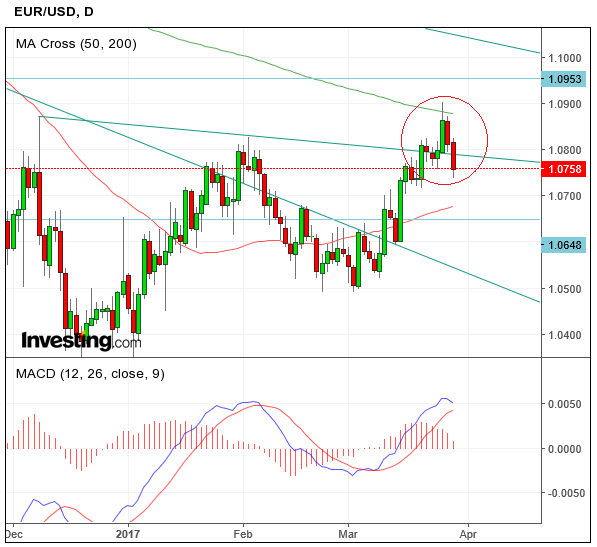Euro to US Dollar: Midweek Review, Pulling Back Steeply

The EUR/USD chart is showing the pair in its second day of decline after failing to break above the 200-day moving average at 1.0877.
The exchange rate has also now moved below the key trendline at 1.0800 which is a relatively bearish sign given the break above the line was thought to be a key turning point for the pair which would usher in a new more bullish phase.

The exhaustion gap which opened up this morning at the highs, is a further sign supporting the view that the uptrend may be reversing, however, it is not corroborated by the market structure, which only shows an a-b-c correction lower has formed so far, although a break below 1.0700 would provide more bearish technical evidence and is a probable turning-point level for the pair.
The MACD has also now just poked below the zero-line signalling the short-term trend is on the cusp of turning negative.

Data for the Euro
The main release for the Eurozone is inflation data for March, out on Friday, March 31 at 9.00 GMT.
The results will feed into the debate about whether the European Central Bank (ECB) is likely to wind down its stimulus efforts or not. A higher inflation print – particularly Core Inflation – will make it more likely the ECB will normalize policy sooner than previously expected.
A reduction of monetary stimulus would be positive for the Euro as it would result in higher interest rates which tend to lift currencies by attracting more inflows of foreign capital.
Headline inflation is forecast to show a 1.8% rise in March year-on-year.
Analysts at TD Securities think that there is a chance Eurozone (headline) inflation will slowdown in March; commenting on German CPI data they said:
“We look for inflation to ease off in March after Feb’s strong 2.2% (yoy) print, as the contribution from oil prices declines due to both lower base effects and their outright decline in March, and the timing of Easter leads to a further dip.”
Data for the Dollar
US data has been strong in recent weeks, with Durable Goods Orders showing robust gains, New Home Sales rising by 6.1% and the Current Account deficit shrinking – all positives for the Dollar going forward.
In the week ahead, however, all eyes will be trained on Personal Consumption Expenditure (PCE), out on Friday, March 31 at 12.30 GMT because it has a material impact on Federal Reserve Policy.
Investors were disappointed after the Fed March meeting and sold the Dollar, because Fed members continued to show distrust at the economic recovery, and seemed unlikely to raise interest rates at their June meeting.
If Core PCE rises above its 1.7% February result (yearly) or beats expectations of a 0.2% month-on-month gain, it will bolster the Dollar, by increasing expectations of a June interest rate rise.
Higher interest rates are supportive of a currency as they attract more inflows of foreign capital seeking yield.
TD Securities expect Headline PCE to rise above 2.0% signalling steeper rises in inflation and more gains, potentially, for the Dollar.
The other main data highlight for the Dollar ia Michigan Sentiment in March, out at 14.00 on Friday, which is forecast to remain at 97.6, and Expectations to rise to 87.0 from 86.7 in the previous month.










